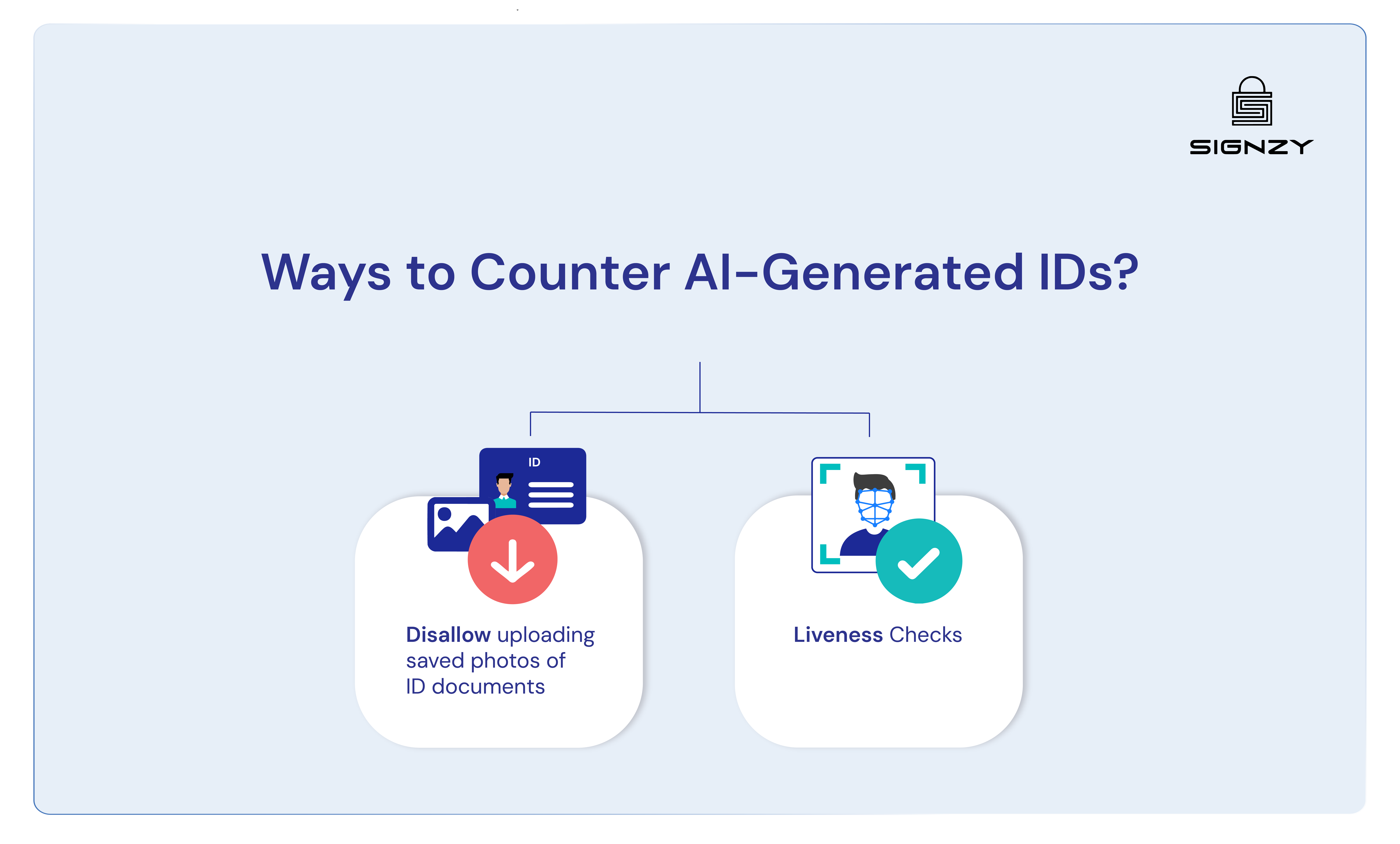AI-generated fake IDs — How Your Business can Counter the Attacks
- Learn about how offenders use AI to create fake IDs, how these fake IDs are used, and how many people have used fake IDs.
- The OnlyFake Crisis: What it is, how people used it, and how these fake IDs can be recognized..
- Banks and financial organizations ask for specific documents while performing KYC – proof of identity (e.g., passport, driver’s license) and proof of address (e.g., utility bills, bank statements).
- How can your business counter this problem with improved ID verification? Methods to avoid usage of fake IDs and how Signzy can help with these methods.
Fake IDs have been a problem for businesses for the longest time. With the introduction of AI to the mix, the process has gotten much easier for offenders as they can produce these false identities at a greater rate. According to a report by AuthenticID, more than half of American businesses reported receiving fake ID documents in 2023.
However, verification processes have not stopped growing either. The increase in the use of fake IDs has had a benefit too. Verification mechanisms now have a bigger training data pool to be better able to tell the difference between fake IDs and genuine ones.
Related Solutions
How does AI Create Fake IDs?
By using AI, offenders can create fake IDs using stolen information such as Social Security Numbers, photos, driver’s license numbers, and more.
While this process was already in place before the advent of AI, the use of Artificial Intelligence has led to these false identities being produced at a much larger scale.
Using this information, people create something known as synthetic identities. These synthetic identities combine stolen data with made-up information to create a completely new false identity.
According to a survey conducted by IDScan.net, 7% of high school students admitted to owning a fake ID. The number grew to 69% in the case of college students, who admitted to owning or having used a fake ID.
While in these cases, the fake IDs were mostly used to buy alcohol or get into clubs, fake IDs are also used to commit credit card, loan, or other financial fraud.
One primary offender in this fake ID crisis was OnlyFake. Selling fake IDs for as low as $15, the platform soon grew to be a significant problem for businesses.
The OnlyFake Crisis
404 Media, a news outlet, did an exposé on the underground online platform called OnlyFake. The platform could allegedly generate photos of fake IDs using “neural networks” for only $15.
While a lot of experts believed that OnlyFake did not use AI for the complete ID generation process, it was believed that AI was used to create a large number of renders of fake IDs. These renders were then worked on manually to create convincing images of fake IDs like driver’s license, passports and more.
💡 Related Blog:
Allegedly, the site’s users could either input data like name, address, pictures and generate an OnlyFake ID, or use a pre-generated render already present on the website.
How to Detect AI-Generated IDs
While platforms like OnlyFake present a real threat against the identity verification of customers of any business, there are a few signs that help differentiate these fake IDs from real ones. Some of these signs are:
- Distorted or missing holograms
- Missing state seals on driving licenses
- Irregular or incomplete text
- Missing machine-scannable code
- Low-quality ID image
Ways to Counter AI-Generated IDs

Identity verification needs to keep up with these trends for the security of businesses as well as their customers. Some ways that businesses can employ to fight the growing trend of fake IDs are as follows:
- Disallow uploading saved photos of ID documents: Most fake IDs are not physical copies and hence are saved as images on their user’s device. By making users upload a live photo of their ID, businesses can save their ID verification processes from fake IDs.
- Liveness Checks: Another way to ensure the authenticity of ID verification is to perform liveness checks. With liveness checks, customers need to upload live pictures of their faces. These pictures can then be compared with the uploaded ID to complete the identity verification.
How Signzy Helps
Signzy has a whole suite of tools to help with the identity verification of your customers. Our ID verification APIs include DL Verification, Optical Character Recognition (OCR), Liveness Checks, Passport Checks, PEP Screening, and more.
These APIs can help your business improve its ID verification process and aren’t too complex either, so your customers do not drop off during the onboarding process. Signzy offers all of these tools, and more, at the most economical rate in the industry. So if you’re looking to keep your business’ identity verification up to date, visit our website and learn more!
Conclusion
While the introduction of AI to the fake ID issue caused some problems, the silver lining in this cloud remains that businesses will only keep improving their ID verification processes to keep up. This translates to greater credibility for the businesses, and improved customer safety and satisfaction.
FAQ
Can AI generate ID cards?
Can AI create fake images?
Can AI generate fake human faces?

Roshan Kumar
Roshan leads product strategy for Identity and Fraud Verification at Signzy Technologies, where he oversees the development of secure, scalable ID Verification, Automated CKYC, and AI-powered Video KYC solutions for regulated banks and fintechs. With over five years of hands-on experience in KYC and API banking and a strong engineering background, he focuses on building platforms that ensure seamless and compliant onboarding across the BFSI sector. His expertise spans designing and implementing solutions that address evolving regulatory requirements and industry challenges.




![Phishing in the world of AI: New-age phishing [Examples + Prevention tips]](https://cdn.sanity.io/images/blrzl70g/production/5e62fb1a441678be5d0b7fde0bbfe0c0d14a2b0b-2560x600.webp)



